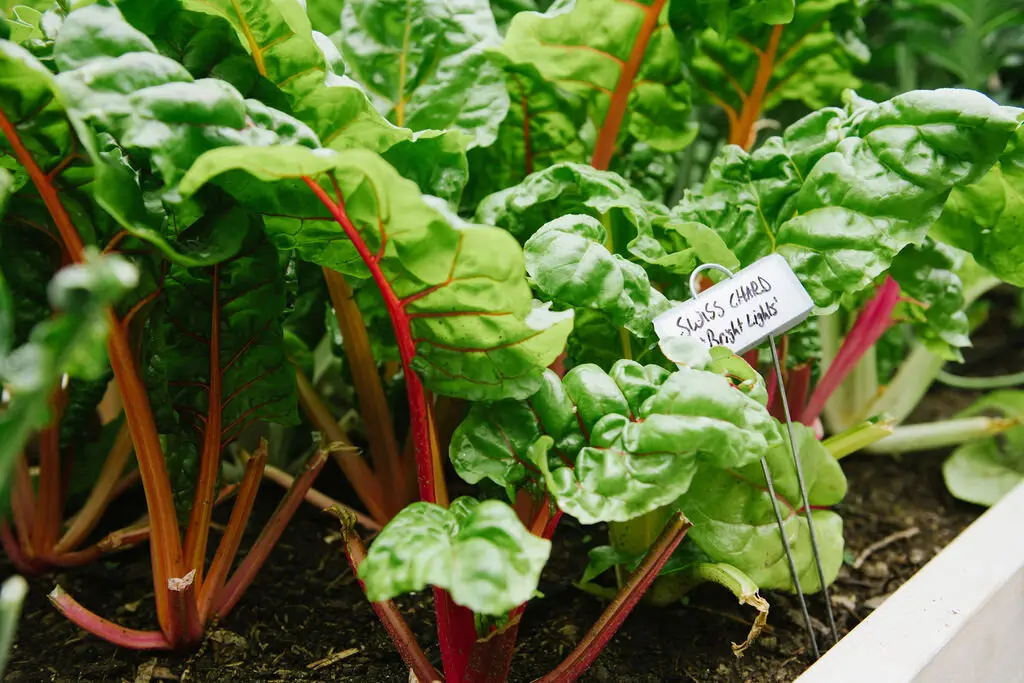Get The Most Out of Your Swiss Chard from Backyard Eats
Harvesting Swiss Chard
When It’s Ready
- Ready for harvest when plants are established (4-6 weeks after planting)
- When the plants are about 9″ tall and the leaves are large enough to eat
How To
- Snap or cut mature leaves at the base near its connection to the crown
- Harvest the biggest couple of leaves from each plant
- Leave smaller inner leaves to continue growing. New leaves will grow for harvest in 1-2 weeks
Growing Swiss Chard
Swiss chard is a leafy green vegetable that is similar to spinach and beet greens. It has a slightly bitter and earthy flavor, with a slightly sweet taste that becomes more pronounced when cooked. Swiss chard can be sautéed as a side dish, simmered in a soup, or added to a stir fry for a fresh flavor and bite.
Note on Row Cover
We cover beets, spinach, and swiss chard with a white row cover to prevent leaf miner bug damage. This is NOT a sun-protection or germination cover, and should be left on the plants for as long as possible throughout the season. We may remove the row cover around spring plants as necessary to interplant summer crops. If you see leaf miner scars on plants, they are still edible and can be picked around.
Storing Swiss Chard
Fresh is best for this vegetable, but here are some tips if you can’t cook the day of harvest.
Fresh Storage: Place in airtight bags or containers and refrigerate. Don’t crush leaves, but it’s ok to compress gently to save on bag space.
Long-Term Storage: Freeze whole leaves: Blanch in boiling water, dunk in ice bath to retain color, dry, and freeze in storage bag.

Cooking With Swiss Chard
Swiss chard is a fibrous green. This means it needs to be cooked with some water over a period of time before it’s palatable. In a sauté or soup recipe, add the fibrous stems 5 minutes before adding the tender leaves to ensure even cooking, or omit the stems. You can use Swiss chard in place of spinach in most recipes.
- Sautéed Swiss Chard: Remove the stems from Swiss chard leaves, then chop the leaves into strips. Sauté them in olive oil with garlic, onions, and a pinch of red pepper flakes until wilted and tender. Season with salt and pepper to taste.
- Swiss Chard Salad: Slice Swiss chard leaves into thin ribbons and toss them with a vinaigrette dressing, cherry tomatoes, cucumbers, and feta cheese. The hearty and slightly bitter leaves of Swiss chard make for a nutritious and flavorful salad.
- Swiss Chard Wraps: Use Swiss chard leaves as a substitute for tortillas or wraps. Fill them with your favorite ingredients, such as roasted vegetables, grains, beans, or grilled chicken, for a healthy and gluten-free alternative.
- Swiss Chard and White Bean Soup: Sauté chopped Swiss chard stems and leaves with onions, garlic, and carrots. Add vegetable or chicken broth, white beans, and herbs. Simmer until the flavors meld together, creating a comforting and nourishing soup.
- Swiss Chard Stir-Fry: Stir-fry Swiss chard leaves and stems with other vegetables like bell peppers, mushrooms, and tofu or meat. Add soy sauce, ginger, and garlic for a flavorful and nutritious stir-fry.




